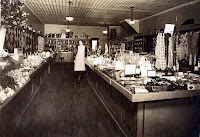
"My mama made all these things from cotton bags."
"Up until the mid-1800s, storage containers were primarily wooden barrels, boxes, tins and to some extent, pottery. It was the abundant source of cotton from the South which enabled the transformation to cotton bags for flour, sugar, meal, grain, salt and feed."
"With the introduction of sewing machines, bag manufacturing and sales increased although were still too expensive for most companies to purchase. As late as the 1880s barrels were still the preferred storage unit but by WWI they had all but disappeared."
"It was the depression which created a real demand for bags as frugal housewives discovered they could reuse and recycle them. Empty bags were prey for conversion into boys underpants, children’s clothing, aprons, dresses and everything else imaginable."
Source.Examples.Examples.Feedsacks were initially made of heavy canvas, and were used to obtain flour, sugar, meal, grain, salt and feed from the mills. They were reusable, with the farmer bringing an empty sack stamped with his mark or brand to the mill to be filled. Feedsacks were initially printed on plain white cloth and in sizes that corresponded to barrel sizes. The brand name was simply printed on the side of the bag.
Size and weave of the bags depended on the product and manufacturer. By 1914, sacks came in 10, 6, 4, 3, 2 and 1 pound sizes, though they were standardized in 1937.
Source.More info.Relevant packaging history in a nutshell.In 1905, machinery was invented to automatically produce in-line printed paper bags. With the development of the glued paper sack, the more expensive cotton flour sacks could be replaced. But a sturdier multiwalled paper sack for larger quantities did not replace cloth until 1925, when a means of sewing the ends was finally invented.
Paper and paperboard packaging increased in popularity throughout much of the 20th century. The first paperboard carton -- often called a cardboard box -- was produced in England in 1817, Another common form of "cardboard" based on corrugated paper appeared in the 1850s. The strength, lightness, and cheapness of this material make it very useful for shipping and storing. However, replacing wooden crates with the new paper alternative would prove to be something of a battle. Nevertheless, about 1910, after much litigation between manufacturers and the railroads, shipping cartons of faced corrugated paperboard began to replace self-made wooden crates and boxes used for trade. The development of flaked cereals advanced the use of paperboard cartons. The Kellogg brothers were first to use cereal cartons. Their original packaging was a waxed, heat-sealed bag of Waxtite wrapped around the outside of a plain box. The outer wrapper was printed with the brand name and advertising copy.
Owens invented the first automatic rotary bottle-making machine, patented in 1889. Suddenly, glass containers of all shapes and sizes became economically attractive for consumer products, and from the early 1900s until the late 1960s glass containers dominated the market for liquid products.
Since food was now safe within metal packaging [~1810], other products were made available in metal boxes. In the 1830s, cookies and matches were sold in tins and by 1866 the first printed metal boxes were made in the United States for cakes of Dr. Lyon's tooth powder. Although commercial foils entered the market in 1910, the first aluminum foil containers were designed in the early 1950s while the aluminum can appeared in 1959.
History of packaging





























 General Store, Wisconsin
General Store, Wisconsin General Store, Washington County c. 1915
General Store, Washington County c. 1915














